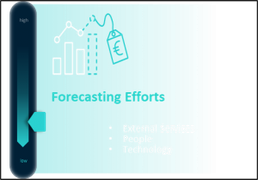- Home
- /
- SAS Communities Library
- /
- Introduction to Demand Forecasting using SAS Intelligent Planning Clou...
- RSS Feed
- Mark as New
- Mark as Read
- Bookmark
- Subscribe
- Printer Friendly Page
- Report Inappropriate Content
Introduction to Demand Forecasting using SAS Intelligent Planning Cloud
- Article History
- RSS Feed
- Mark as New
- Mark as Read
- Bookmark
- Subscribe
- Printer Friendly Page
- Report Inappropriate Content
The purpose of this blog is to explain the automated demand forecasting used within SAS Intelligent Planning.
I will focus on discussing the demand forecasting process and how forecasting restoration and hybridization will provide you with increased confidence in the demand forecasting process.
The two fundamental messages of how demand forecasting with SAS can help, is:
- First, lower forecasting efforts leading to cheaper forecasts. The process tangibly reduces the amount of effort from various departments & people that go into the forecasting process.
- second, significantly improved forecasting accuracy
How Demand Forecasting Helps
A lot of this improvement in productivity is achieved by
- SAS’ capability to automate the forecasting process including the ability to select the most suitable forecasting models for
every occasion. This allows the user to focus just on the exceptions.
- The ability to include relevant external data and combine this with the client’s internal data further enhances the improvement in forecast accuracy.
- Automated demand forecasting of most SKUs will be completed at the relevant item and/or store level.
- The solution will automatically test and apply the best fitting analytical models (See 'Model Training using Time Series and Machine Learning Forecasts' section below) for each time series class with model stability.
- Your various data sources will be integrated to include internal and external predictors.
- And the solution will use an automatic historical demand restoration (See 'Demand Restoration' section below) when considering product Lifecyle in the forecasting process.
What is the Demand Forecasting Process
- Your data is inputted through a preprocessing step that prepares the data for the model forecasting.
- Preprocessing includes demand restoration, forecast flag calculation and demand driver preprocessing.
- Model training uses machine learning models and time series models to automatically apply the most accurate forecast. Machine learning models will provide a lower level forecast typically done at a SKU/store level.
- While time series models will provide a higher level forecast typically at category/region level.
- The solution provides alert notification and forecast autocorrections as part of the forecast post process.
- The goal is to ensure low-touch forecasting for the user with embedded forecast autocorrections and prebuilt alerts.
- Alerts are notifications to check whether the generated statistical forecasts are reasonable or require checking.
- These alerts can be viewed in prebuilt reports. Auto corrections help detect inadequate forecasts and bring them to a confidence interval.
- These are very useful when a forecast value is too high or small for a single location/product pair.
How does Demand Restoration Help Prepare Data
During preprocess SAS runs a step called Demand Restoration to recover missing historical values.
These missing data samples are preprocessed as they might decrease forecast accuracy. Demand restoration could be applied to the following examples:
- Out of stock or insufficient stock periods or periods in the training sample.
- Promotional periods, considering the degree of the promotion.
- Phase-out period of life-cycle and history of sales before phase-out.
- Introduction period of life cycle for regular assortment forecasting.
Threshold minimums and various inventory flags help identify stock levels, stock shortages, and promotional periods.
The combination of threshold minimums and inventory flags improves the demand restoration process rather than just using a single out-of-stock flag.
Using those inventory thresholds and flags can improve historical data sales enrichment up to 20%.
Model Training using Time Series and Machine Learning Forecasts
Automatic Time Series Classification will segment the time series models on the bases of patterns that were detected. Each time series model is then classified automatically into one of the pre-defined segments. These segments are based on seasonality, low volume, and intermittent and non intermittent patterns. The benefits of this process is recognizing that different types of times series models require different types of strategies. It improves forecasting accuracy for individual segments or groups within your data. The automated classification of time series will apply the appropriate strategy.
Feature engineering is one of the key tasks involved in the Machine Learning forecasting. These features allows SAS to build learning sets that can incorporate up to 1000 features in the Machine Learning models. Here are a few example of the many features that can be utilized in the modeling process:
- Promotions – Determines how products behave based on promotions such as price decreases, advertising, or store location for the promo (like an endcap or an aisle display).
- Calendar Events – such as Christmas, Easter, Valentines
- Prices – Changes in price over time when the item has not been promoted
- Lag Features – Looks at how historical shipment volumes at different aggregations impact demand. Analyzing quantities available to be sold compared to demand.
- Master Data – can use product and location characteristics to view patterns. Here you can see variance is patterns due to regional preferences.
Once the solution calculates the machine learning and time series forecasts, the solution will run the step called forecast Hybridization. This is where the ML & TS forecasts are combined according to defined consolidation logic. We start with the ML and TS forecasts. There are a multiple forecasts created, short term, long term, with and without promo features. Each one as a specific forecast quantity. Using demand classification attributes, the consolidation step creates a forecast mix with the goal of obtaining baseline and total forecasts. The Promo forecast is derived as the different between the total forecast and the baseline forecast.
Summary
In summary automated demand forecasting helps you improve your forecasting accuracy while reducing the forecast related efforts. In the input data preprocessing step, demand restoration can enhance your historical sales data by up to 20%, increasing forecast accuracy. During model training, the baseline and total forecasts are automatically created by consolidating the multitude of created forecast using a process called Forecast Hybridization. The last step of input data preprocessing, contains alert notification and embedded forecast auto corrections that help provide you with a low touch forecast process.
April 27 – 30 | Gaylord Texan | Grapevine, Texas
Registration is open
Walk in ready to learn. Walk out ready to deliver. This is the data and AI conference you can't afford to miss.
Register now and lock in 2025 pricing—just $495!
SAS AI and Machine Learning Courses
The rapid growth of AI technologies is driving an AI skills gap and demand for AI talent. Ready to grow your AI literacy? SAS offers free ways to get started for beginners, business leaders, and analytics professionals of all skill levels. Your future self will thank you.
- Find more articles tagged with:
- GEL




